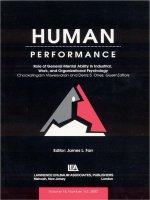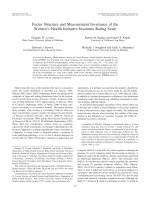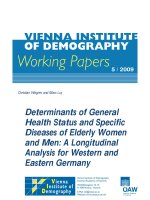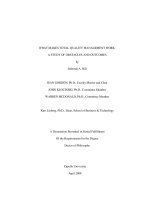Work and Earnings of Low-Skilled Women Do Employee and Employer Reports Provide Consistent Information
Bạn đang xem bản rút gọn của tài liệu. Xem và tải ngay bản đầy đủ của tài liệu tại đây (593.42 KB, 46 trang )
Work and Earnings of Low-Skilled Women:
Do Employee and Employer Reports Provide Consistent Information?
Geoffrey L. Wallace
Institute for Research on Poverty
La Follette School of Public Affairs
Department of Economics
Robert M. La Follette School of Public Affairs
University of Wisconsin - Madison
1225 Observatory Drive
Madison, WI 53706-1211
Tel. (608) 265–6025
Fax (608) 265–3233
Robert Haveman
Institute for Research on Poverty
La Follette School of Public Affairs
Department of Economics
Robert M. La Follette School of Public Affairs
University of Wisconsin - Madison
1225 Observatory Drive
Madison, WI 53706-1211
Tel. (608) 262–4585
Fax (608) 265-3233
June 2007
Abstract
The employment and earnings effects of the state-oriented federal welfare reform legislation of
1996 have been extensively studied using either survey or administrative data. Because information may
differ substantially across these sources, it is difficult both to identify the true effects of these
interventions and to compare evaluation estimates of these interventions that rely on these different data
sources. This paper uses data gathered as part of the Wisconsin Child Support Demonstration Evaluation
to examine the extent to which administrative (unemployment insurance) and survey records on
employment and earnings for a sample of low-skilled women are congruent. Our findings suggest that
there are substantial differences in both mean earnings and mean employment rates between survey and
unemployment insurance (UI) data. We identify the extent to which these disparities can be explained by
differences between these data sources in the definition of earnings or the method of data collection. We
also examine the differences between UI and survey sources in estimates of employment and earnings
growth among low-skilled women.
Work and Earnings of Low-Skilled Women:
Do Employee and Employer Reports Provide Consistent Information?
I.
INTRODUCTION
For reasons that are not well understood, welfare receipt and welfare income have been
increasingly underreported in national surveys. While underreporting of welfare receipt has always been a
problem in national surveys, it has grown worse since states began implementing Temporary Assistance to
Needy Families (TANF) programs in 1997 [Meyer and Sullivan, 2006]. Additionally, even if national
surveys accurately measured welfare receipt (as they were designed to do in larger states before welfare
reform), it seems doubtful that state-level comparisons would be reliable given the dramatic decrease in
caseloads—from over 5 million to about 2 million—since 1994.
Because of these difficulties associated with national survey data, researchers have turned to
state-level survey and administrative data to evaluate the impacts of welfare reform and to monitor the
post-reform outcomes for target populations. One common form of data consists of cross-sectional or
longitudinal surveys administered to a subset of a state’s caseload that collect information on earnings,
employment, demographic characteristics, and living arrangements. A second source of information is
from state administrative data containing work and earnings information gathered as part of employers’
reports to the Unemployment Insurance System (UI).
The potential existence of two sources of information on individual-level earnings for individual
states makes it difficult to compare results within and across states. In this paper, we explore the extent of
differences in individual employment and earnings measures between those collected as part of a careful
survey of 2,200 welfare-oriented women in Wisconsin and those reported by employers to the UI system.
Both sources of data are available through a unique experimental research project undertaken at the
Institute for Research on Poverty at the University of Wisconsin-Madison, the Wisconsin Child Support
Demonstration Evaluation (CSDE).
2
In the CSDE project, single, low-skilled female resident parents in the state of Wisconsin who
receive or have received welfare cash assistance are studied over time in an effort to assess their
behavioral responses to a specific reform in child support policy. In the study, 100 percent of the child
support paid by noncustodial parents is passed through to the treatment group, and 41 percent to a
maximum of $50 per month is passed through to the control group. The CSDE survey is comprehensive,
inquiring about a variety of individual choices and living arrangements, in addition to socioeconomic and
demographic information. Information on the extent of work in a particular year and the earnings
associated with that work is sought for each respondent. Uniquely, the survey also inquires about a
detailed set of work-related attributes, such as the nature of the payments made (e.g., wages, tips, or the
receipt of monetary payments from odd jobs), and the number of jobs held in a year. We use this
information in analyzing the potential sources of differences in reports of work and earnings between the
survey and the administrative UI data.1, The project also obtained detailed information on the work and
earnings of each covered person included in the program from employer reports compiled by the
Wisconsin Unemployment Insurance (UI) program, which indicate whether a person has worked during a
quarter and their quarterly earnings.
Our analysis proceeds as follows. In Sections II through IV we examine differences in the
definitions of work and earnings between the survey and UI reports and in the data collection methods.
These differences suggest a number of reasons for discrepancies between work and earnings reports in the
two data sources, and between these information sources and some unknown ‘true’ value of earnings.
Data from the two sources reveal the extent of the discrepancies between them. In Section V we use
information available in the CSDE survey regarding the personal characteristics, location, extent of
1
The CSDE survey is unique in its efforts to secure reliable information on work and earnings responses.
The special circumstances of low-skilled women are reflected in explanations of the questions asked of survey
respondents regarding the nature and extent of their work and earnings. In seeking information about earnings, it
was explained that the question referred to “the total income you earned from all jobs combined during . . . [the
year].” The respondent was explicitly told to exclude any money that was received from the public
workforce/welfare agency, even though that payment required a specific amount of work. Self-employment was
explained, and respondents were told that income from this activity is also to be included. In cases where the
respondent reported not knowing her income in a particular year, the interviewer was advised to “probe for the best
estimate.”
3
welfare use, and job characteristics of the workers in our sample to examine the correlates of the work
and earnings discrepancies and the extent to which our conjectures regarding the sources of these
discrepancies are able to explain the observed patterns. Finally, Sections VI and VII explore the extent to
which the use of survey or UI data affects empirical estimates of the determinants of employment and
earnings and estimates of the levels and changes in these variables across groups of workers. Section VII
concludes.
II.
SOURCES OF EARNINGS AND EMPLOYMENT DIFFERENCES IN SURVEY AND UI
RECORDS
Relative to some unknown ‘true’ employment and earnings values there are reasons to suspect
under- and over-reporting in both survey data and UI reports. UI earnings and employment may be
underreported, reflecting potential incentives for both employees and employers to underreport earnings
together with the difficulty in tracking some sources of income. For example, while the full amount of
receipts of each employee’s tips, bonuses, and commissions are required to appear in employer reports to
the UI system, the incentives to underreport, combined with the difficulty of tracking income from these
sources, make it likely that they are consistently underreported. Underreporting also exists because some
employment categories are exempt from UI reporting requirements (e.g., self-employed workers, farm
laborers, domestic workers, and some part-time employees of nonprofit institutions). It is estimated that
UI records cover about 91 percent of Wisconsin workers. Workers may be falsely classified into these
exempt categories, resulting in underreports of both earnings and employment in the UI data.
Underreports in the UI data can also occur because the earnings of workers residing in one state and
working in another are unlikely to be reported by the employer to the UI system in the state of the
employee’s residence.2 The UI reporting system may also contain erroneous work and earnings
information due to errors in recording Social Security numbers or in matching UI wage records. These
errors may reflect intentional or non-intentional noncompliance. Finally, it is worth noting that
2
Only the states of Missouri and Kansas have agreements to share information from UI reports.
4
aggregating quarterly UI earnings to an annual earnings measure will tend to exacerbate the measurement
problems described above. Overall, the combined effect of these sources of potential bias suggests that UI
employment and earnings measures are likely to be lower than ‘true’ earnings values.
Although most jobs are covered by the UI system, both employment and earnings for low-wage
workers may be seriously underreported in UI reports. Relying on an extensive audit of a sample of 875
Illinois firms in 1987, Blakemore et al. [1996] and Burgess, Blakemore, and Low [1998] collectively
conclude that about 45 percent of employers failed to report earnings of some UI covered employees, 13.6
percent of their covered workers had no reports, and 4.2 percent of wages were excluded. These
underreports were concentrated among smaller firms; for firms with less than 5 workers, 56.5 percent of
workers and 14.1 percent of earnings were unreported during the third quarter of 1987. The incorrect
classification of some workers as uncovered independent contractors and high employee turnover
accounted for much of the underreporting of work and earnings. Nearly half of all unreported workers
were improperly classified by their employers as independent contractors [Blakemore et al.]. Because
firms are responsible for paying UI taxes on employees up to an earnings threshold, those with high
turnover must pay taxes on a larger portion of their total payroll; as a result, they are more likely to
underreport workers and earnings [Burgess et al.].
Individual survey responses regarding work and earnings may also have errors. Employment and
earnings from illegal activities, irregular work, odd jobs or reciprocal tasks for friends, family and
neighbors tend to be underreported in survey responses. To the extent that respondents view the survey as
an instrument for obtaining information that may affect them adversely, survey information will
understate the true level of employment and earnings. For example, all of the women included in the
sample were welfare recipients at some point during late 1997 or 1998, during which time Wisconsin had
a 100 percent tax rate on the earnings of welfare recipients. Finally, error may arise from survey responses
5
regarding work and earnings in the distant past or for periods of intermittent activity, and from the
imputing of earnings values for workers who report that they do not know their earnings.3
Several studies have attempted to describe the extent of measurement problems in survey data by
matching records from a survey (the Panel Study of Income Dynamics or March Current Population
Survey) with ‘true’ earnings measures [Bound and Krueger, 1991; Bound et al., 1994]. These studies
indicate that there are substantial individual-level differences between survey and ‘true’ earnings, but that
this measurement error does not result in substantial biases in estimated coefficients from earnings
regressions. In these studies, the ‘true’ value of earnings is taken to be earnings from payroll records of a
large unionized manufacturing firm [Bound et al.] or earnings from Social Security Administration (SSA)
records [Bound and Krueger]. We note that these ‘true’ earnings measures are themselves subject to error.
For example, firm payroll records neglect earnings from second jobs, and SSA records exclude earnings
from informal sector work.
Abowd and Stinson [2003] also note that these sources of ‘true’ earnings are themselves
measured with error. Using matched earnings data from the Survey of Income and Program Participation
(SIPP) and employers’ W-2 reports, they investigate the extent of measurement error in both sources of
data. They find that there is a substantial degree of measurement error in both SIPP earnings data and the
matched administrative earnings data, but that the ratio of true variation to measurement error is actually
lower for the SIPP earnings reports.
A number of studies have made direct comparisons between survey earnings measures and UI
measures for low-skilled populations. Using a sample of Job Training Partnership Act (JTPA) experiment
participants that contained both UI and survey earnings, Kornfeld and Bloom [1999] found substantial
3
When a respondent reports that they “don’t know” their earnings in 1998, the survey administrator follows
up with a series of questions designed to gain information about whether the respondent's earnings fell into certain
intervals. Given the design of the survey instrument, the prospective earnings intervals start high, with each
additional question inquiring if earnings fall into a lower interval. Because the questions start high and work their
way to lower intervals, it may be more likely that respondents indicate that their earnings fell into a relatively high
interval. In cases where respondents “don’t know” their earnings, we interpolate their earnings as the midpoint of the
indicated earnings interval. Because of this interpolation, and the design of the survey, we may obtain an upward
biased estimate of survey earnings for respondents reporting that they “don’t know” earnings relative to the true
value.
6
differences in individual-level and mean earnings. Twenty-six percent of adult men and nearly 15 percent
of adult women had quarterly survey and UI earnings values that varied by more than $1,000; mean
survey earnings were approximately 30 percent higher than mean UI earnings for both groups. Despite
large mean and individual-level differences in survey and UI earnings, estimates of the impact of JTPA
training were not substantially affected by which earnings measure was used. 4
There are also a number of studies of women who exited state welfare programs that relied on
both survey and UI measures of employment and earnings. 5 As in the Kornfeld and Bloom study, surveybased employment rates and earnings exceed those from administrative data. One difficulty with many of
these state-level studies is that the comparability of survey and UI employment and earnings measures are
questionable because the time frames covered by the surveys differ from those covered by the UI reports. 6
The CSDE survey that we analyze avoids this problem, as earnings are measured annually, allowing
comparability with UI records.
III.
DISCREPANCIES IN EMPLOYMENT REPORTS
The most basic indicator of labor market performance is whether or not a person is employed
during a specific period of time. For the 2,179 women in our sample, job-holding at any time during 1998
is recorded in both the survey and the UI data. For the UI data, we regard observations with positive UI
earnings during any quarter of 1998 as working during that year. Table 1 reports a cross-tabulation of
survey and UI employment indicators for the 2,179 women in our sample. Eighteen percent have
conflicting employment information from the two data sources. Eighty percent of these discrepancies are
due to having UI, but no survey, reports of earnings. Because of these discrepancies, the survey and UI
4
Kornfeld and Bloom also review the findings of prior studies that have compared employment and
earnings data from administrative records to those based on individual responses to survey questions. Such studies
include Hotz and Scholz, 2002; Rodgers, Brown, and Duncan, 1993; Moore, Stinson, and Welniak, 1997; Baj, Trott,
and Stevens, 1991; Baj, Fahey, and Trott, 1992; Burgess, Blakemore, and Low, 1998.
Acs and Loprest (2002) review these studies; see also Issacs and Lyon (2000).
5
6
For example, one study of welfare leavers compares quarterly UI employment and earnings (pre-exit to 4
months post-exit) to point-in-time survey records of employment and monthly earnings 12 to 18 months postwelfare exit. See Arizona Department of Income Security (2000). Additionally, UI employment is measured
quarterly while survey employment is usually measured at a point in time.
7
reports indicate quite different employment rates—83 percent using the UI data and 74 percent from the
survey reports.
It will be helpful for our further analysis to distinguish the groups in the various cells of Table 1.
We label the 1,514 women in the first row/first column as sure workers because they are employed
according to both data sources. Relying on the same rationale, we label the women in the second
row/second column as sure nonworkers. Because the women in the first row/second column report some
earnings in the survey, we classify them as probable workers, even though no employer report of earnings
is recorded in the UI data. Because we know from employer reports that the 305 women in the second
row/first column were working in 1998 in spite of their own reports of non-employment, we refer to them
as false nonworkers, and conclude that these women either forgot that they had worked or misrepresented
their earnings to survey interviewers.
IV.
DISCREPANCIES IN EARNINGS REPORTS
Consistent with the disparities in alternative reports of employment, large differences exist
between earnings reported by CSDE sample respondents and earnings reported by employers in
accordance with UI reporting requirements. Figure 1 presents a scatter plot of the two earnings values for
the entire sample of 2,179 women. The y-axis shows reports of earnings from the CSDE survey (S) and
the x-axis employer reports of earnings actually paid (UI). The 272 sure nonworkers (zero earnings in
both data sources) are concentrated at the origin of the figure. The 88 probable workers (zero UI earnings
but positive S earnings) are shown along the x-axis, and the 305 false nonworkers (zero S earnings but
positive UI earnings) are displayed along the x-axis. The 1,514 sure workers (those with positive earnings
in both data sources) are shown in the interior of the figure. Were there no disparity between S and UI
earnings, all of the observations would lie along the 45-degree line that divides the quadrant into two
parts. Clearly such observations are a rare occurrence. While there is a substantial degree of
nonconformity between S and UI earnings, there is a strong positive relationship between the series. The
8
sample correlation between survey and UI earnings is 0.66 for the entire sample, and 0.65 among the sure
workers.
Figure 2 provides another view of these disparities for the separate groups of women in our
sample. Mean levels of S and UI and the S—UI earnings difference for each group are shown in the
figure. Sure workers are shown in the positive quadrant of the figure, and we distinguish workers for
whom the absolute value of the earnings difference exceeds $2,500 from those for whom the difference
lies within $2,500 of the 45-degree line. We selected $2,500 value because the range minus $2,500 and
$2,500 correspond roughly to the 5th and 95th percentiles of the S—UI earnings difference. The 88
probable workers are shown on the left side of the figure; they have positive S earnings but no UI
earnings. Forty of these probable workers report S earnings of more than $2,500, while having reported
UI earnings of zero. Average S earnings for this group of 40 women are over $10,500. The 305 false
nonworkers are shown at the bottom of the diagram. There are 115 of these women who indicate no S
earnings but for whom employers report average UI earnings of more than $2,500. Employer-reported
earnings for this group of false nonworkers with UI earnings above $2,500 average nearly $7,500.
In order to assess the degree of divergence between S and UI earnings we use two measures of
the discrepancy between the two values—the mean absolute difference (MAD) and the mean squared
difference (MSD). The MSD is the mean squared difference between S and UI earnings; it is also equal to
the variance of the difference between S and UI earnings around zero. Like all measures of variance, the
MSD can be decomposed into systematic and random components, a property that we exploit below.
Table 2 reports average S and UI earnings by employment group, the fraction of the sample in
each group, the two discrepancy indicators, and the percentage of both the total absolute discrepancy (
∑S
i
− UI i ) and the total squared discrepancy (
∑( S
− UI i ) ) attributable to each employment group.
2
i
The top bank of Table 2 indicates significant variation in the extent of the earnings discrepancy across the
groups of workers. For example, the MAD for sure workers is $2,894, compared to $3,310 for false
nonworkers, and $5,480 for those who report having worked but who have no employer reports of
9
earnings (probable workers). For the average sure worker the mean value of S exceeds that of UI by
nearly $1,200, or by 18 percent. While sure workers comprise about 69 percent of all observations, they
account for 75 percent of the total absolute discrepancy and 71 percent of the total squared discrepancy.
The bottom bank of Table 2 shows the distribution of MAD and MSD across five categories of
sure workers. Sure workers with absolute earnings differences of less than $2,500 have a MAD of only
$851. While they comprise over 66 percent of the sample of sure workers, they account for only 20
percent of the total absolute discrepancy among these workers, and but 3 percent of the total squared
discrepancy. On the other hand, the 23 percent of sure workers for whom S exceeds UI by more than
$2,500 have a MAD of over $7,000 and account for 59 percent of the sure worker total absolute
discrepancy, and for 73 percent of the sure worker total mean squared discrepancy. The 10 percent of sure
workers for whom UI exceeds S by more than $2,500 have a MAD of about $6,000, and also account for
a disproportionate share of both the total absolute discrepancy and the total squared discrepancy.
The last two categories divide sure workers into steady and unsteady workers. The 509 steady
workers are those who worked at least 3 quarters in 1998 and had no more than two employers according
to both UI records and the survey. As the numbers in Table 2 indicate, steady workers have higher average
earnings than unsteady sure workers, probable workers, or false nonworkers. Despite their high levels of
earnings, steady workers have lower levels of earnings discrepancy than other groups of workers. The
MAD for steady workers is $2,626 compared with $3,029 for the unsteady workers. The difference in the
MSD between steady and unsteady workers is more striking. Steady workers have a MSD of 18.83
million compared with 27.64 million for other sure workers.
The distribution of the algebraic difference between S and UI earnings (S—UI) among all sample
members is shown in Table 3.7 Also shown is an approximation to the distribution of the earnings
difference from a sample of women who were Job Training Partnership Act trainees reported by Kornfeld
7
The distribution of the (S – UI) discrepancy for the subsample of sure workers is similar to that for the
entire sample, although the subsample of sure workers has larger fraction of observations with survey earnings
substantially in excess of UI earnings.
10
and Bloom [1999].8 There is substantial conformity between our estimates of the S—UI discrepancies and
those of Kornfeld-Bloom. For both samples, 45–50 percent of the observations have an earnings
discrepancy of less than $800, and about 30 percent of the observations report survey earnings that exceed
UI earnings by more than $2,400. However, while about 8 percent of the women in our sample have UI
earnings that exceed survey earnings by more than $4,000, only about 3 percent of the observations in the
Kornfeld-Bloom sample have (S—UI) values greater than $4,000. 9
V.
EVALUATING SOME CONJECTURES CONCERNING THE SOURCES OF EARNINGS
DISCREPANCY
As we have noted, a variety of differences in concept, definition, and reporting procedures
between the survey and the UI data system may contribute to the discrepancies between S and UI
earnings reports. Other factors also contribute to the discrepancies, such as the likelihood of working in
the informal sector, being an irregular (unsteady) worker, or respondent reports of difficulty in recalling
earnings information. In Table 4, we indicate several conjectures regarding the source and magnitude of
the earnings discrepancy between the S and UI data.
The CSDE survey provides detailed information that allows us to explore the impact of a number
of these factors on the survey-UI earnings discrepancy. For example, in addition to providing extensive
information on demographic variables, the CSDE survey identifies the receipt of income from odd jobs,
8
Kornfeld and Bloom provide quarterly earnings estimates for their sample of women. We have
‘annualized’ their estimates by multiplying their quarterly earnings class intervals by four, hence forcing
comparability with our annual values.
9
One possible explanation for the thicker and longer bottom tail of the distribution of the earnings
difference for the workers in our sample may be the creation of annual S earnings values for the Kornfeld-Bloom
observations by multiplying quarterly values by a factor of 4. Because problems of recall are smaller in quarterly
than in annual survey data, the distribution of quarterly earnings is likely to show less dispersion than the
distribution of annual earnings for these same observations. Hence, the distribution of discrepancies between S and
UI is likely to be smaller for the annualized Kornfeld-Bloom data than for the annual data on women in our sample.
Moreover, the types of errors made in quarterly reporting are likely to be compounded in annual surveys, and reports
of annual earnings reflect larger intertemporal employment variation than is present over a quarter. Second, the
Kornfeld -Bloom numbers are from a sample of women that volunteered for training associated with the Job
Training Partnership Act, whereas the sample used in our analysis is composed of women who were on welfare at
some point during late 1997 or early 1998. All else equal, the workers in the Kornfeld-Bloom sample are likely to
have a greater attachment to the formal sector of the labor force than the workers in our sample, and hence a smaller
discrepancy between S and UI.
11
tips, and commissions. We can also identify those respondents who indicate that they “don’t know” their
precise earnings, and those for whom estimates of these ‘unknown’ values must be imputed. Information
describing the welfare and work histories of the observations obtained from administrative data has been
merged to the survey data. This information includes the number of months respondents received cash
welfare assistance through AFDC in the two years prior to being assigned to Wisconsin’s TANF program,
and the fraction of 1998 calendar year that respondents received cash assistance. Finally, the survey also
contains information on the county of residence for each respondent, the number and characteristics of
jobs/employers during the year, and the nature of job and payment arrangements.
A.
Correlates of Being a False Nonworker
We first estimate a multinomial logit model to identify factors that are related to whether survey
respondents are false nonworkers (those with positive UI earnings but no survey earnings), probable
workers, or sure workers.10 For this estimation we use the 1,907 observations that fall into one of these 3
groups. False nonworkers are of particular interest as they apparently either forgot that they worked in
1998, or intentionally misreported their work status. Because many of these women have perceived
incentives to hide their earnings, some of them may have intentionally misreported their earnings. We
found that average UI earnings for false nonworkers is $3,310.
Table 5 presents the results of this estimation. The coefficients show the relative risk (or odds)
ratio associated with a unit change in each of the independent variables; coefficients greater (less) than
one indicate a larger risk of falling into the indicated group relative to the reference group by a factor
equal to the coefficient. Because false nonworkers and probable workers are lacking reports of either S or
UI earnings or employment, the specification is parsimonious. For example, in the case of false
nonworkers, the characteristics of the job obtained from the survey (e.g., hourly or salary basis, receipt of
10
All of the statistical analysis present in this paper was conducted using the integrated statistical software
package STATA. For more information about STATA and its capabilities consult the STATA website at
/>
12
tips and commissions) are unreported. In the case of probable workers characteristics of employment
obtained from the UI records, such as the number of employers, are not available.
Women with low education levels are more likely to be false nonworkers than are those with
more schooling. Although Hispanics (and other non-whites and non-blacks) are much less likely to be in
the sure worker category than whites, they are as likely to be a probable worker as a false nonworker.
Aside from this effect, race-ethnicity does not appear to effect worker group status. Residing in an urban
area (Milwaukee or another urban area) also appears to be associated with being a false nonworker;
however, neither of these variables is statistically significant at standard levels. While residing outside of
Wisconsin for part of the year seems likely to reduce employer reports of work and earnings (and, hence,
to increase the likelihood of being a probable worker relative to the other categories), the effect of this
variable is not statistically significant.
By far the largest determinate of having some missing source of earnings information is the
fraction of 1998 during which cash assistance is received. Being on cash assistance for all of the year,
compared with none of it, increases the likelihood of being a false nonworker (relative to the other two
categories), consistent with the perceived incentive to hide earnings among women receiving welfare.
Welfare receipt also increases the likelihood of being a probable worker relative to a sure worker,
consistent with the incentive to hide income, perhaps through the use of non-matched Social Security
numbers. The magnitude of this effect is very large. If the entire sample of workers were on cash
assistance for all of 1998, we predict that 35 percent of them would be false nonworkers and 6 percent of
them would be probable workers, compared to the 16 and 3 percent who are actually in these categories.
Conversely, if none of the workers in this sample received welfare in 1998, we would expect 90 percent
of them to be sure workers, compared to the observed 80 percent, with the bulk of this 10 percentagepoint decrease being due to a reduced fraction of false nonworkers.11
11
As noted, the percent of 1998 that the worker receives welfare also increases the likelihood of being a
probable worker relative to being a sure worker. This effect is such that 2 percent of the sample would be probable
workers conditional on none of the sample being on welfare in 1998, compared to 6 percent in the actual sample.
13
Because Wisconsin taxes the earnings of welfare recipients at 100 percent, the question arises
whether the large impact of welfare recipiency on the likelihood of being a false nonworker or probable
worker arises from intentional misrepresentation of earnings by respondents. While it is impossible to
answer this question with certainty, we can shed some light on this issue. If false nonworker status is due
to intentional misrepresentation, we would expect false nonworkers (who report no survey earnings) to be
more likely to have a positive UI earnings report in the quarters that they received cash assistance than
sure workers. However, this is not the case, as false nonworkers are in fact less likely to have UI earnings
in quarters in which they received cash assistance (about 52 percent of such quarters) than are sure
workers (66 percent of such quarters).12
B.
Correlates of the Discrepancy between Earnings Reports among Sure Workers
We also estimate a multivariate regression to explore the consistency of our conjectures with
earnings discrepancies between S and UI reports. The regression is run over the sample of sure workers
with the aim of identifying the sources of the discrepancy among workers who have positive earnings
reports in both data sources. The dependent variable measuring the earnings discrepancy is the difference
between S and UI earnings (S—UI)/1000; with this specification, each coefficient (x 1,000) is interpreted
as the change in the difference between S and UI earnings associated with a unit change in the indicated
characteristic.
In Table 6 we present the results of our regression of (S—UI)/1000 on individual socioeconomic
characteristics, the work and welfare history variables, and a set of variables designed to reflect our
conjectures (e.g., location, welfare receipt, intermittent or informal employment, job characteristics, and
the elapsed time since last worked).
Consider first the conjecture that individuals who have worked for an out-of-state employer have
a large discrepancy. Two of the variables in the model allow us to assess this conjecture. If the conjecture
12
Ideally we would like to determine whether false nonworkers were more likely to have UI earnings in the
months in which they received cash assistance. Because employer reported UI earnings are only available on a
quarterly basis we cannot compare monthly welfare receipt to monthly UI earnings.
14
is correct, then respondents who report living out of state for some portion of 1998 are likely to have
reduced UI earnings relative to survey earnings. Additionally, we might also expect that some respondents
living in border counties would have some earnings that did not appear in UI records because these
earnings were paid by out-of-state employers. The estimates in Table 6 support this conjecture, indicating
that both living out of state in 1998 and residing in a border county lead to higher (S—UI) earnings
differences. The effect of living out of state in 1998 is not statistically significant, but the effect of
residing in a border county is.13
With respect to the nature of work and the sources of compensation, we hypothesized that
earnings from tips, commissions, and odd jobs are likely to be undercounted in UI records relative to
survey earnings. Consistent with this conjecture, the estimated effect of working an odd job in 1998 is to
increase the (S—UI) earnings difference by approximately $670. The presence of income from tips and
commissions is also estimated to increase the (S—UI) earnings difference, but the effect of this variable is
not statistically different from zero at standard confidence levels.
Other conjectures concerned the role of being a steady worker (vs. a nonsteady worker), difficulty
in recalling earnings because of intermittent employment, or having a long gap between the time of
employment and the date of the survey, all of which suggest error in survey earnings, but no particular
directional bias in the S—UI earnings difference. In the model reported in Table 6, we included a dummy
variable indicating being a steady worker.14 The coefficient on this variable is large, negative, and
statistically significant, suggesting that steady workers have a smaller (S—UI) earnings difference than do
13
It appears that most of this border county effect can be attributed to Kenosha County, an urban county
located in the southeast corner of Wisconsin bordering populous Lake County, Illinois, and accounting for a large
share of the state’s public assistance caseload. Lake County, Illinois, is just to the north of Cook County, Illinois,
which contains the city of Chicago. In a separate analysis available from the authors upon request, border county
status was interacted in the state that the county bordered and included in the Table 6 specifications. This analysis
indicates that there is a large positive effect of living in a county bordering Illinois on the survey – UI earnings
difference, and that the effect of living in counties bordering other states is smaller and not statistically
distinguishable from 0. When a separate control for Kenosha County was added to this model, the effect of living in
a county bordering Illinois is reduced to the point that it is similar in magnitude and significance to the effect of
living in a county bordering another state. We believe that the level of economic development in Lake County,
Illinois, along with its close proximity to Kenosha County, Wisconsin, provides opportunities for Kenosha County
residents to work out of state that are not present in other border regions.
14
Recall that a steady worker is a sure worker who worked at least 3 quarters in 1998 according to UI
records and who had no more than two employers according to both UI and survey records.
15
nonsteady workers. When the effects of this steady worker variable are netted out, there is little evidence
that the number of quarters worked (reflecting intermittent work) or the time between the last quarter
worked and the survey date15 have a large impact on the (S—UI) earnings difference; the coefficients on
both variables are relatively small and imprecisely estimated.
Although the number of quarters and last quarter worked in 1998 do not have statistically
significant effects on the (S—UI) earnings difference, we predict higher survey earnings for a given level
of UI earnings for workers that report that they “don’t know” their earnings; the coefficient on this
variable is large and statistically significant. We are unable to identify the extent to which this effect
reflects difficulty in remembering earnings, our imputation procedure 16, or intentional misrepresentation.
Finally, consider the effect of the welfare receipt variable (the fraction of 1998 the respondent
received cash assistance) on the difference between survey and UI earnings. Because the Wisconsin
Works (W2) program does not allow recipients to work for pay and receive cash assistance, there is an
incentive for women who wish to work and receive program benefits to attempt to conceal their earnings,
even in cases where confidentiality is promised. In the survey, these incentives toward concealment may
lead to underreporting of earnings. In the UI data the incentives toward concealment may lead to women
working under false Social Security numbers, working off the books, or working odd jobs. Increased time
on welfare in 1998 may lead to underreporting of both survey and UI earnings, meaning that its effect on
(S-UI) is ambiguous. The coefficient in the model indicates a significant and positive effect of spending
time on cash assistance on the (S—UI) earnings difference.
In addition to the estimates shown in Table 6, we also estimated a model excluding the work and
welfare history variables. The coefficient estimates for this model are similar to those in the model shown
in the table; a joint significance test rejects the hypothesis that the coefficients in the two models are
significantly different from each other. The model was also run over an analysis sample that excludes
15
The 1998 CSDE survey was administered in the spring of 1999 to correspond with the time that many
workers would be looking back over their earnings records for the purpose of filling out tax returns. Because there
was a uniform period of survey administration, the last quarter worked in 1998 is a proxy for the time between when
a worker was last employed and when she is asked to recall her earnings on the survey.
16
See footnote 13.
16
observations that indicated that they do not know their earnings, and for whom earnings values were
imputed (see note 13). The results from this model are again very similar to those discussed in the paper,
In sum, with but few exceptions, our conjectures regarding the sources of the discrepancy between survey
and UI earnings reports are confirmed in these estimates.
C.
Simulated Effects of Selected Conjectures on the Total Discrepancy
The model reported in Table 6 can be used to simulate the quantitative contribution to the
discrepancy between S and UI earnings of those factors expected to be related to this outcome. The
discrepancy variable we use in this simulation is the MSD, and we simulate the percentage change in this
variable attributable to each of the conjecture variables and to groups of these variables. Our simulation
approach rests on the decomposition characteristics of the MSD measure, and is described in detail in
Appendix A.
In our simulation, we set the variables of interest to values suggesting the absence of the expected
effect (while holding all of the other variables at their observed levels) and record the estimated change in
MSD. Our results, stated as the simulated percentage changes in MSD attributable to these alternative
values of the conjecture variables are summarized below.
•
Border county = 0:
-1.12 percent
•
Out of state in 1998 = 0:
-0.0 percent
•
Fraction of 1998 receiving cash assistance = 0:
3.91 percent
•
Odd job and tips and commissions = 0
-1.58 percent
•
Steady worker = 1
-6.22 percent
•
Overtime = 0
-0.19 percent
•
Don’t know earnings = 0
-1.68 percent
•
Last quarter worked was the third or fourth quarter
-0.86 percent
17
Consistent with the conjectures, the presence of workers living in a border county increases the
MSD, as does having an odd job, receiving tips and commissions, not being a steady worker, not knowing
earnings, and last working prior to the third quarter of the year. Of the two conjecture variables for which
the direction of the effect could be in either direction, having an overtime pay arrangement reduces the
discrepancy, while assuming that no time is spent as a welfare recipient is associated with an increased
MSD.
While this last finding seems counterintuitive, it has a sensible interpretation. Being on welfare
during a year is associated with reduced earnings. For example, average survey and UI earnings for
sample members who spent all of 1998 receiving cash assistance are $734 and $593, respectively,
compared with $9,025 and $8,641 for sample members who spent none of 1998 receiving cash assistance.
It follows that the absolute level of the survey-UI earnings discrepancy is also lower for those with low
earnings relative to those with high earnings. Hence, simulating the effect of assuming that no worker was
a welfare recipient results in both increased earnings levels and a greater level discrepancy between
them.17
Using this same model, we also simulate the aggregate effect of two sets of conjecture variables
on the mean squared discrepancy, one reflecting inadequacies in the UI measure and the other
inadequacies in the survey measures; again, we set these variables at levels indicating the absence of the
conjectured effect. The results are as follows:
•
Variables reflecting the failure of UI to accurately capture earnings
(living in a border county or out of state, having an odd job
or receiving tips/commissions)
-2.65 percent
•
Variables reflecting the failure of S to accurately capture earnings
(due to forgetting or misrepresentation, including not being a
-7.51 percent
17
Given the importance of the level of survey and UI earnings in determining the discrepancy between the
two values, it might be informative to estimate a model of the difference between log survey and log UI earnings. In
such a model the independent variables would influence the percentage difference between survey and UI earnings,
rather than the level difference between survey and UI earnings, by a constant amount. We estimated this model with
the same set of independent variables as in the Table 6 specifications. While the estimated results were similar to
those in Table 6, and the accompanying simulations, the fraction of 1998 spent on cash assistance had a lower
simulated effect on the mean of the squared difference in log survey and UI earnings than on the MSD. The results
of these log difference regressions are available from the authors upon request.
18
steady worker, having overtime pay arrangements, not knowing
earnings, or last working prior to the third quarter of the year)
Overall, then, the variables that we have been able to study because of the detailed information
available in the CSDE data account for about 10 percent of the total discrepancy. Factors that we are
unable to measure—such as fixed difference in survey and UI reports not related to independent variables
in the model,18 simple random variation, or nonsystematic effects of the conjecture variables—account for
the bulk of the total discrepancy.
For example, in addition to their systematic impacts on the discrepancy, the conjecture variables
might influence the discrepancy by affecting the random component of either survey or UI earnings
reports. To explore the extent to which nonsystematic effects of the conjecture variables increase the
variability of earnings reports, and thus the discrepancy, we have regressed the squared residuals from the
Table 7 regression on the independent variables. Two of the independent variables in this regression—the
steady worker and the “don’t know” variables—are statistically different from zero at standard confidence
levels.19 Being a steady worker leads to survey and UI reports that are more consistent, while not knowing
earnings in 1998 leads to survey reports that are substantially less consistent. The magnitude of these
effects is large. We estimate that MSD would be reduced by 26 percent if the entire sample of sure
workers were steady workers.20 MSD would be reduced by an additional 8.5 percent if none of the sure
workers in the sample reported not knowing their earnings. Thus, a substantial amount of the noisy
reporting of both S and UI earnings can be explained by the unsteady nature of work, problems of recall,
or the misrepresentation of earnings by sample members.
VI.
DO EMPLOYMENT AND EARNINGS FUNCTIONS VARY BY S AND UI?
Given the nature of these observed discrepancies between survey and UI data, an important
question is whether there is a significant difference in the conclusions obtained from equations estimated
18
The mean difference in survey and UI earnings accounts for about 6 percent of MSD.
19
The results of this regression are available from the authors upon request.
20
This is above and beyond the 6.22 percent reduction in MSD resulting from the systematic effect of
steady worker status reported above
19
with these alternative variables. To answer this question, we estimated simple models of employment and
earnings, using both data sources.21 The independent variables in each of these equations are age, age
squared (divided by 100), indicators of educational attainment (high school dropout, high school graduate,
and some college), and indicators of race (white, black, Hispanic or other). These models are estimated
over two samples: all women who appeared in the 1998 and 1999 surveys and sure workers that appeared
in the 1998 and 1999 surveys.
We conducted an F-test of the equivalence of the coefficients (or sets of coefficients) across the
two regressions for each group of women. These results are summarized in Table 7. For the models
using all of the observations, a substantial number of estimated relationships differ significantly between
the survey and UI measures of earnings. In particular, significant differences between the coefficients on
the education variable estimated using the alternative earnings variables are indicated; an F-test on the
entire set of coefficients indicated significant differences in estimated effects depending on the earnings
data used in estimation. These differences do not exist when the earnings functions are fit over only all
sure workers; in no cell of Table 7 estimates fit over this group of workers are significant differences
indicated. We conclude that estimates of the determinant earnings and employment are somewhat
sensitive to the source of data of the dependent variable, especially for estimates fit over full samples of
observations.
VII.
DO ESTIMATES OF TOTAL AND GROUP-SPECIFIC EMPLOYMENT, EARNINGS, AND
POVERTY STATUS VARY BY S AND UI?
Studies of low-income women, especially the numerous studies of welfare leavers [Cancian,
Haveman, Meyer, and Wolfe, 2003], monitor the employment and earnings of these workers over time in
order to assess the effects of policy reform efforts. Both UI and survey information are used in these
assessments of the performance of leavers. Our data allow us to estimate the extent to which these
21
The equation for employment was estimated as a logit model, while the earnings regression was estimated
using OLS. Employment in both the survey and UI data was defined by the presence of positive earnings.
20
patterns vary by the source of the information used, ultimately aiding in reconciling information across
different studies.
Because the monitoring studies often emphasize subgroup differences in employment and
earnings, we present the (S—UI) differences in these variables for race and education subgroups using
data on all respondents and all sure workers included in both the 1998 and 1999 surveys. We also show
subgroup differences in estimates of earnings growth between the two sources of information.
Consider first the comparisons of employment rates shown in Table 8. For all of the subgroups,
the employment rate based on UI information exceeds that based on the survey data. The S/UI ratios
range from .81 to .97, suggesting quite different patterns among the groups based on the source of
information. For all subgroups, the patterns of change in employment rates from 1998 to 1999 based on
survey data are larger (suggesting more growth or smaller decreases) than those based on UI information.
A similar pattern of differences in the level of earnings is shown in Tables 9 and 10 for all
workers and sure workers, respectively. For all workers, the S/UI ratio of earnings ranges from 1.03 to
1.23 across the subgroups. For sure workers, S exceeds UI even more, and S/UI ranges 1.12 to 1.18
across the subgroups. For sure workers, earnings growth for all of the subgroups is greater when
measured using UI information, but for all workers the S and UI differences in growth patterns vary
across the subgroups.22
Overall, the use of survey information tends to understate employment levels but overstate
earnings among low-skilled female workers, relative to information from administrative records. Surveybased employment rates tend to be about 90 percent of those based on administrative records. Conversely,
earnings for sure workers estimated from survey-based information are about 16 percent higher than those
based on UI data, and about 12 percent higher for all women. For sure workers, the ratios of survey to UI
earnings are similar among the race-education subgroups, but vary substantially between subgroups when
all workers are studied.
22
For example, earnings growth among educated nonwhites of 35 percent is suggested by the survey data,
compared to 33 percent when UI earnings are used. For less educated nonwhites the pattern is reversed, with 35
percent growth indicated by the UI information and 14 percent when survey data are used.
21
In terms of employment growth, use of survey information yields larger employment increases
for all of the subgroups. However, earnings increases based on UI information tend to be larger than when
survey information is used. For all workers the patterns of earnings growth among nonwhites without a
high school diploma differ substantially across the S and UI data, but other groups show similar patterns
of earnings growth across the two sources of earnings information. These results suggest that analysts
tracking the employment and earnings growth of welfare leavers or other populations of low-skill workers
need to interpret carefully the patterns that they observe.
VIII.
CONCLUSIONS
Using data on a large sample of low-skill women with children, we find substantial disparities in
employment and earnings reports between a uniquely high-quality survey of low-skilled workers and
employer-based reports of earnings. These differences exist for both steady workers and those who work
intermittently and on several jobs. Some of these differences are to be expected because of differences
between the two data sources in coverage, definition, and the process of data collection.
We propose several “conjectures” for these discrepancies reflecting both the differences in
definition and data collection between survey and UI information sources, and the location or job-related
characteristics of the workers. Using information available in the survey, we measured the relationship of
these worker and employment characteristics to the work and earnings discrepancies among the workers
in the sample. Although the survey data are unique in the extent of detailed information regarding work
and earnings patterns they provide, we were able to account for only about 10 percent of the total
discrepancy; the great bulk of the discrepancy is due to random error in data reporting or recording or
definitional or employment differences for which we are unable to account.
Our estimates of the effect of the alternative data sources on both econometric estimates of the
determinants of work and earnings outcomes and the reliability of measures of employment and earnings
levels and trends (such as those reported in studies designed to monitor the labor market success of low-
22
skill women, such as welfare leavers) suggest the need for caution by researchers in interpreting results
from such studies.
23
Appendix
Our simulation approach relies on the least squares decomposition of the sum of the squared
dependent variable. Assuming that
( Si − UI i )
= xi '×β + ei ,
the average squared discrepancy can be decomposed as follows:
MSD =
=
1 n
1 n
1
2
2
S
−
UI
=
β '×xi ×xi '×β + ∑ ( S i − UI i − xi '×β )
(
)
∑
∑
i
i
n i =1
n i =1
n i
1 n
1
β '×xi ×xi '×β + ∑ ei 2
∑
n i =1
n i
(1).
This decomposition indicates that the mean squared discrepancy (MSD) is due in part to
systematic effects of the x variables and in part to random differences in S and UI. The ratio of the first
right-hand-side term in (1) to the MSD is the fraction of the variance of survey less UI earnings around
zero that is due to the x variables (including the intercept term). One minus this fraction is attributable to
random errors in reporting.
The coefficients in Table 7 provide estimates of the β used in this simulation. With estimated
µ ) replacing the actual coefficients and actual residuals ( e$) replacing the error terms, we
coefficients ( β
obtain the following decomposition:
MSD =
2
1
1
1
2
( Si − UI i ) = à 'ìxi ìxi 'ìà + ∑ e$i
∑
n i
n i
n i
This decomposition yields an estimate of the variance of (S-UI) around zero explained by the
independent variables.
We simulated the effect of the conjecture variables (as a subset of the x variables) by setting
them to alternative values and measuring the estimated change in MSD . For example, we assume that no
worker lived in a border county, no worker lived out of state, and no worker received income from tips









